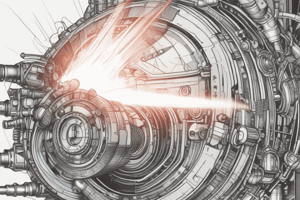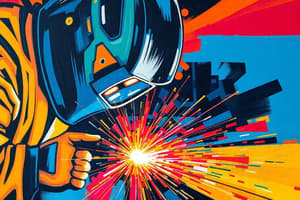Podcast
Questions and Answers
Which of the following tests is NOT a type of Non-Destructive Testing (NDT)?
Which of the following tests is NOT a type of Non-Destructive Testing (NDT)?
- Dye-penetrant inspection
- Ultrasonic inspection
- Fillet weld break test (correct)
- Visual inspection
The heat affected zone (HAZ) refers to the part of a weld that has not been subjected to welding heat.
The heat affected zone (HAZ) refers to the part of a weld that has not been subjected to welding heat.
False (B)
What is the primary purpose of a welding procedure qualification (WPQ)?
What is the primary purpose of a welding procedure qualification (WPQ)?
To validate the welding procedure and ensure it meets safety and quality standards.
The ______ test evaluates the strength and ductility of a welded joint by applying tension.
The ______ test evaluates the strength and ductility of a welded joint by applying tension.
Match the following types of testing with their descriptions:
Match the following types of testing with their descriptions:
Which of the following welding processes involves a non-consumable electrode?
Which of the following welding processes involves a non-consumable electrode?
The design of weld joints includes factors such as sizing of welds and edge preparation.
The design of weld joints includes factors such as sizing of welds and edge preparation.
What is the primary purpose of shielding gas in welding?
What is the primary purpose of shielding gas in welding?
In welding, the _______ describes the distribution of voltage along the welding arc.
In welding, the _______ describes the distribution of voltage along the welding arc.
Which factor affects arc efficiency in welding?
Which factor affects arc efficiency in welding?
Match the welding processes with their characteristics:
Match the welding processes with their characteristics:
All types of shielding gases have the same effect on the welding arc.
All types of shielding gases have the same effect on the welding arc.
What is meant by the term 'duty cycle' in welding applications?
What is meant by the term 'duty cycle' in welding applications?
Flashcards
Weld Joint Testing
Weld Joint Testing
Methods used to evaluate the quality and strength of weld joints, including chemical, metallographic, hardness, and mechanical tests.
Non-Destructive Testing (NDT)
Non-Destructive Testing (NDT)
Inspection methods that assess weld quality without damaging the weld.
Heat Affected Zone (HAZ)
Heat Affected Zone (HAZ)
The area of the base metal near a weld that undergoes changes in microstructure and properties due to heat.
Weldability
Weldability
Signup and view all the flashcards
Carbon Equivalent
Carbon Equivalent
Signup and view all the flashcards
Welding Processes Classification
Welding Processes Classification
Signup and view all the flashcards
Welding Arc Physics
Welding Arc Physics
Signup and view all the flashcards
Welding Power Sources
Welding Power Sources
Signup and view all the flashcards
Consumable Electrode Welding
Consumable Electrode Welding
Signup and view all the flashcards
Heat Flow in Welding
Heat Flow in Welding
Signup and view all the flashcards
Weld Joint Design
Weld Joint Design
Signup and view all the flashcards
Welding Parameters
Welding Parameters
Signup and view all the flashcards
Fatigue Loading in Welding
Fatigue Loading in Welding
Signup and view all the flashcards
Study Notes
Evolution of Welding
- Welding processes have evolved over time.
- Classification of welding processes exists.
- Heat sources and shielding methods are utilized.
Physics of Welding Arc
- Welding arcs exhibit voltage distribution along the arc.
- Cathodes can be thermionic or non-thermionic.
- Theories explain cathode and anode mechanisms.
- Arc characteristics relate to power sources.
- Arc efficiency, heat generation, and shielding gas effects are factors.
- Isotherms of arcs are studied.
Welding Power Sources
- Conventional welding power sources have static and dynamic characteristics.
- Duty cycle is a key parameter.
- Inductance affects arc and power source characteristics.
- Internal and external regulation exists.
- Specific power source requirements vary.
- Special welding power sources are available.
Arc Welding Processes
- Consumable electrode welding processes are a focus.
- Manual metal arc (MMA) welding is described.
- Gas metal arc welding and pulsed MIG welding are explained.
- Submerged arc welding is also discussed, highlighting the importance of flux-metal combinations.
- Electroslag welding, characterized by its heat generation principle, is covered.
- Gas tungsten arc welding, discussing polarity selection, is included.
- Plasma arc welding and its transferred/non-transferred versions are presented, along with gas selection and parameter discussion.
- The keyhole technique is mentioned.
Heat Flow in Welding
- Welding parameters affect heat distribution.
- Peak temperatures and thermal cycles are calculated.
- Cooling rates and solidification are examined.
- Residual stresses, their distribution, and influence on static and dynamic loading are discussed.
- Weld distortion is addressed.
Design of Weld Joints
- Design principles are introduced, including the engineering properties of steels.
- Types of welds and weld joints are described.
- Terminology, definitions, and weld symbols are explained.
- Edge preparation and weld sizing in structures are covered.
- Design considerations for static and fatigue loading are detailed.
- Fatigue, its nature, strength, factors affecting fatigue life, and improvement methods are discussed.
- Reliability analysis and safety factors are applied to fatigue design.
Testing and Inspection of Weld Joints
- Chemical, metallographic, and hardness tests are described.
- Mechanical tests for groove and fillet welds (full section, reduced section, all-weld-metal tensile, root, face, side bend, and fillet weld break tests) are covered.
- Creep and fatigue testing are addressed.
- Non-destructive testing (NDT) methods, including visual, dye penetrant, magnetic particle, ultrasonic, radiographic, and eddy current inspections, are presented.
- Principle of each NDT method is explained.
- Leak tests, NDT standards, WPS, and PQR procedures are noted.
Weldability of Metals
- Solidification of weld metal and the heat affected zone (HAZ) are discussed.
- Factors affecting HAZ properties are outlined.
- Gas-metal, slag-metal, and solid-state reactions in welding and their weld soundness effects are explored.
- Issues like lamellar tearing and hydrogen damage are addressed.
- Weldability definitions, the factors affecting steel weldability, and carbon equivalent are detailed.
- Weldability of important steel, cast iron, and aluminum alloys is covered.
- Failure analysis of welded joints is also included.
Studying That Suits You
Use AI to generate personalized quizzes and flashcards to suit your learning preferences.




